MNG81001: Employee Behavior in Social Media and Organizational Impact
VerifiedAdded on 2023/01/04
|6
|1469
|54
Report
AI Summary
This report delves into the significant impact of social media on employee behavior within an organization, focusing on both positive and negative consequences. It explores the challenges of traditional communication methods compared to the advantages of social media, emphasizing the need for professional management of employee social media usage. The report highlights the potential risks to a company's image and reputation due to employee actions on social media, advocating for the implementation of comprehensive social media policies. It outlines the essential components of such policies, including guidelines on content disclosure, response protocols, and timeframes for social media activities. Additionally, the report provides a communication template designed to help organizations effectively disseminate and enforce social media policies, ensuring the protection of the company's interests and the enhancement of employee engagement.
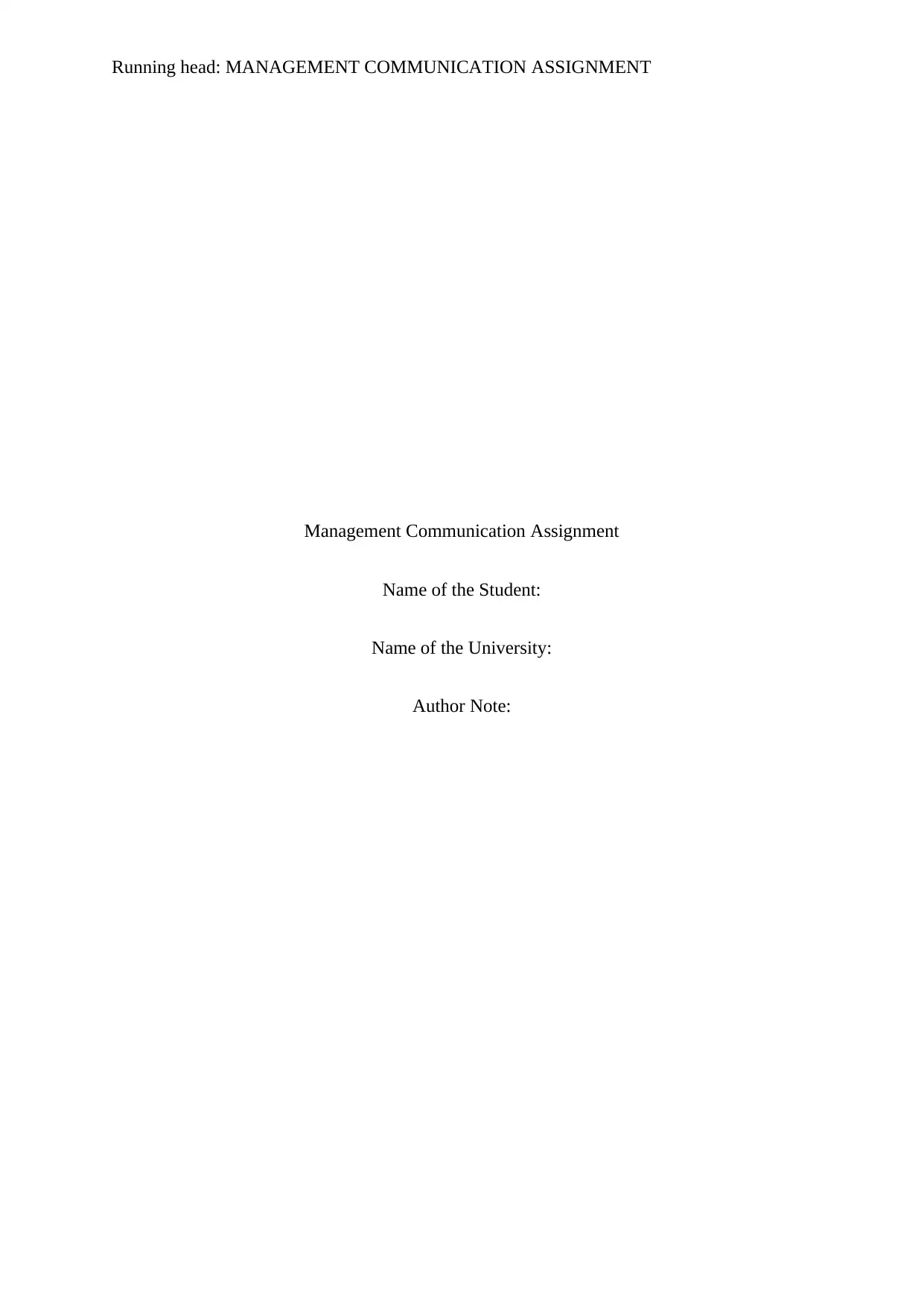
Running head: MANAGEMENT COMMUNICATION ASSIGNMENT
Management Communication Assignment
Name of the Student:
Name of the University:
Author Note:
Management Communication Assignment
Name of the Student:
Name of the University:
Author Note:
Paraphrase This Document
Need a fresh take? Get an instant paraphrase of this document with our AI Paraphraser
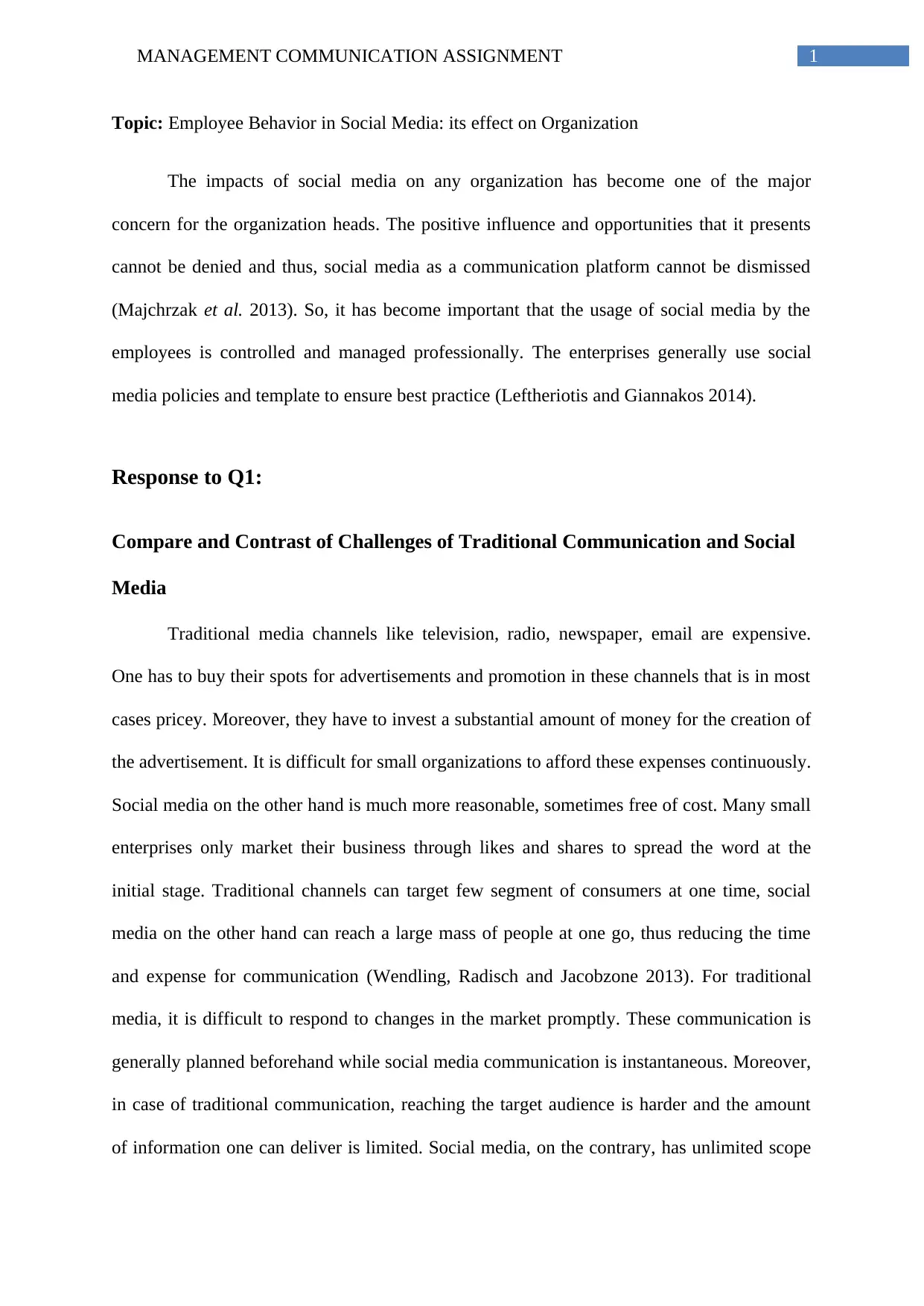
1MANAGEMENT COMMUNICATION ASSIGNMENT
Topic: Employee Behavior in Social Media: its effect on Organization
The impacts of social media on any organization has become one of the major
concern for the organization heads. The positive influence and opportunities that it presents
cannot be denied and thus, social media as a communication platform cannot be dismissed
(Majchrzak et al. 2013). So, it has become important that the usage of social media by the
employees is controlled and managed professionally. The enterprises generally use social
media policies and template to ensure best practice (Leftheriotis and Giannakos 2014).
Response to Q1:
Compare and Contrast of Challenges of Traditional Communication and Social
Media
Traditional media channels like television, radio, newspaper, email are expensive.
One has to buy their spots for advertisements and promotion in these channels that is in most
cases pricey. Moreover, they have to invest a substantial amount of money for the creation of
the advertisement. It is difficult for small organizations to afford these expenses continuously.
Social media on the other hand is much more reasonable, sometimes free of cost. Many small
enterprises only market their business through likes and shares to spread the word at the
initial stage. Traditional channels can target few segment of consumers at one time, social
media on the other hand can reach a large mass of people at one go, thus reducing the time
and expense for communication (Wendling, Radisch and Jacobzone 2013). For traditional
media, it is difficult to respond to changes in the market promptly. These communication is
generally planned beforehand while social media communication is instantaneous. Moreover,
in case of traditional communication, reaching the target audience is harder and the amount
of information one can deliver is limited. Social media, on the contrary, has unlimited scope
Topic: Employee Behavior in Social Media: its effect on Organization
The impacts of social media on any organization has become one of the major
concern for the organization heads. The positive influence and opportunities that it presents
cannot be denied and thus, social media as a communication platform cannot be dismissed
(Majchrzak et al. 2013). So, it has become important that the usage of social media by the
employees is controlled and managed professionally. The enterprises generally use social
media policies and template to ensure best practice (Leftheriotis and Giannakos 2014).
Response to Q1:
Compare and Contrast of Challenges of Traditional Communication and Social
Media
Traditional media channels like television, radio, newspaper, email are expensive.
One has to buy their spots for advertisements and promotion in these channels that is in most
cases pricey. Moreover, they have to invest a substantial amount of money for the creation of
the advertisement. It is difficult for small organizations to afford these expenses continuously.
Social media on the other hand is much more reasonable, sometimes free of cost. Many small
enterprises only market their business through likes and shares to spread the word at the
initial stage. Traditional channels can target few segment of consumers at one time, social
media on the other hand can reach a large mass of people at one go, thus reducing the time
and expense for communication (Wendling, Radisch and Jacobzone 2013). For traditional
media, it is difficult to respond to changes in the market promptly. These communication is
generally planned beforehand while social media communication is instantaneous. Moreover,
in case of traditional communication, reaching the target audience is harder and the amount
of information one can deliver is limited. Social media, on the contrary, has unlimited scope
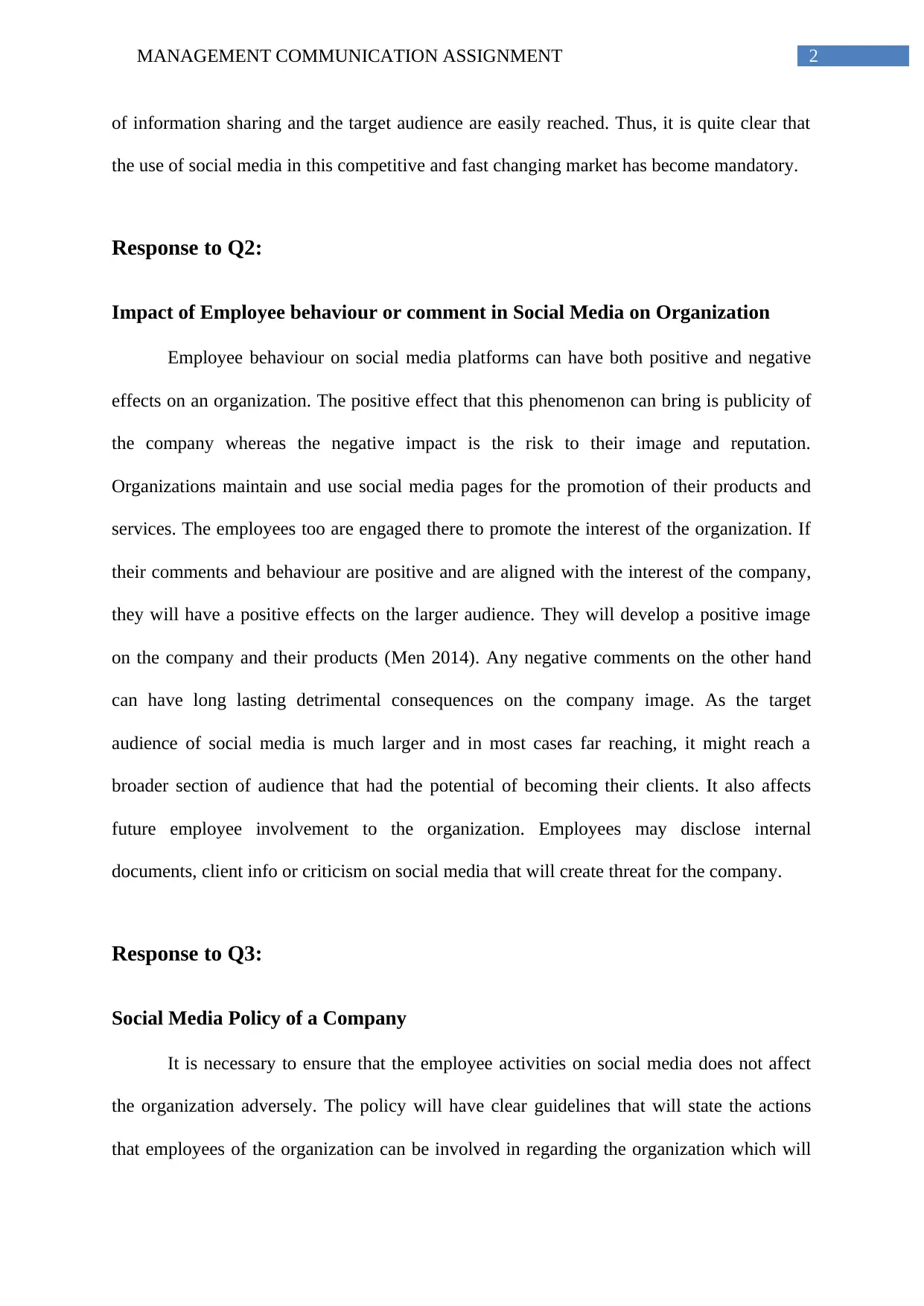
2MANAGEMENT COMMUNICATION ASSIGNMENT
of information sharing and the target audience are easily reached. Thus, it is quite clear that
the use of social media in this competitive and fast changing market has become mandatory.
Response to Q2:
Impact of Employee behaviour or comment in Social Media on Organization
Employee behaviour on social media platforms can have both positive and negative
effects on an organization. The positive effect that this phenomenon can bring is publicity of
the company whereas the negative impact is the risk to their image and reputation.
Organizations maintain and use social media pages for the promotion of their products and
services. The employees too are engaged there to promote the interest of the organization. If
their comments and behaviour are positive and are aligned with the interest of the company,
they will have a positive effects on the larger audience. They will develop a positive image
on the company and their products (Men 2014). Any negative comments on the other hand
can have long lasting detrimental consequences on the company image. As the target
audience of social media is much larger and in most cases far reaching, it might reach a
broader section of audience that had the potential of becoming their clients. It also affects
future employee involvement to the organization. Employees may disclose internal
documents, client info or criticism on social media that will create threat for the company.
Response to Q3:
Social Media Policy of a Company
It is necessary to ensure that the employee activities on social media does not affect
the organization adversely. The policy will have clear guidelines that will state the actions
that employees of the organization can be involved in regarding the organization which will
of information sharing and the target audience are easily reached. Thus, it is quite clear that
the use of social media in this competitive and fast changing market has become mandatory.
Response to Q2:
Impact of Employee behaviour or comment in Social Media on Organization
Employee behaviour on social media platforms can have both positive and negative
effects on an organization. The positive effect that this phenomenon can bring is publicity of
the company whereas the negative impact is the risk to their image and reputation.
Organizations maintain and use social media pages for the promotion of their products and
services. The employees too are engaged there to promote the interest of the organization. If
their comments and behaviour are positive and are aligned with the interest of the company,
they will have a positive effects on the larger audience. They will develop a positive image
on the company and their products (Men 2014). Any negative comments on the other hand
can have long lasting detrimental consequences on the company image. As the target
audience of social media is much larger and in most cases far reaching, it might reach a
broader section of audience that had the potential of becoming their clients. It also affects
future employee involvement to the organization. Employees may disclose internal
documents, client info or criticism on social media that will create threat for the company.
Response to Q3:
Social Media Policy of a Company
It is necessary to ensure that the employee activities on social media does not affect
the organization adversely. The policy will have clear guidelines that will state the actions
that employees of the organization can be involved in regarding the organization which will
⊘ This is a preview!⊘
Do you want full access?
Subscribe today to unlock all pages.

Trusted by 1+ million students worldwide
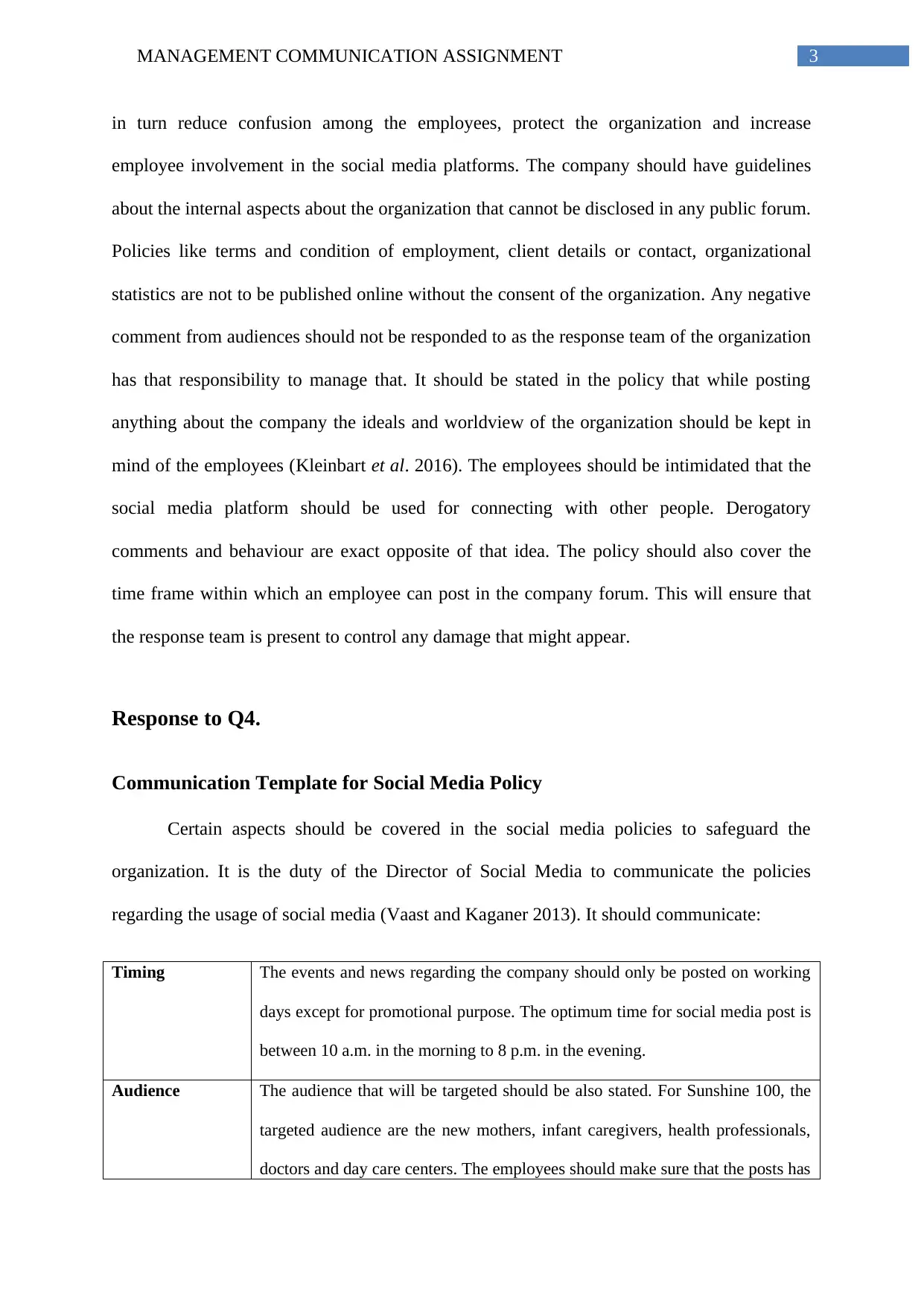
3MANAGEMENT COMMUNICATION ASSIGNMENT
in turn reduce confusion among the employees, protect the organization and increase
employee involvement in the social media platforms. The company should have guidelines
about the internal aspects about the organization that cannot be disclosed in any public forum.
Policies like terms and condition of employment, client details or contact, organizational
statistics are not to be published online without the consent of the organization. Any negative
comment from audiences should not be responded to as the response team of the organization
has that responsibility to manage that. It should be stated in the policy that while posting
anything about the company the ideals and worldview of the organization should be kept in
mind of the employees (Kleinbart et al. 2016). The employees should be intimidated that the
social media platform should be used for connecting with other people. Derogatory
comments and behaviour are exact opposite of that idea. The policy should also cover the
time frame within which an employee can post in the company forum. This will ensure that
the response team is present to control any damage that might appear.
Response to Q4.
Communication Template for Social Media Policy
Certain aspects should be covered in the social media policies to safeguard the
organization. It is the duty of the Director of Social Media to communicate the policies
regarding the usage of social media (Vaast and Kaganer 2013). It should communicate:
Timing The events and news regarding the company should only be posted on working
days except for promotional purpose. The optimum time for social media post is
between 10 a.m. in the morning to 8 p.m. in the evening.
Audience The audience that will be targeted should be also stated. For Sunshine 100, the
targeted audience are the new mothers, infant caregivers, health professionals,
doctors and day care centers. The employees should make sure that the posts has
in turn reduce confusion among the employees, protect the organization and increase
employee involvement in the social media platforms. The company should have guidelines
about the internal aspects about the organization that cannot be disclosed in any public forum.
Policies like terms and condition of employment, client details or contact, organizational
statistics are not to be published online without the consent of the organization. Any negative
comment from audiences should not be responded to as the response team of the organization
has that responsibility to manage that. It should be stated in the policy that while posting
anything about the company the ideals and worldview of the organization should be kept in
mind of the employees (Kleinbart et al. 2016). The employees should be intimidated that the
social media platform should be used for connecting with other people. Derogatory
comments and behaviour are exact opposite of that idea. The policy should also cover the
time frame within which an employee can post in the company forum. This will ensure that
the response team is present to control any damage that might appear.
Response to Q4.
Communication Template for Social Media Policy
Certain aspects should be covered in the social media policies to safeguard the
organization. It is the duty of the Director of Social Media to communicate the policies
regarding the usage of social media (Vaast and Kaganer 2013). It should communicate:
Timing The events and news regarding the company should only be posted on working
days except for promotional purpose. The optimum time for social media post is
between 10 a.m. in the morning to 8 p.m. in the evening.
Audience The audience that will be targeted should be also stated. For Sunshine 100, the
targeted audience are the new mothers, infant caregivers, health professionals,
doctors and day care centers. The employees should make sure that the posts has
Paraphrase This Document
Need a fresh take? Get an instant paraphrase of this document with our AI Paraphraser
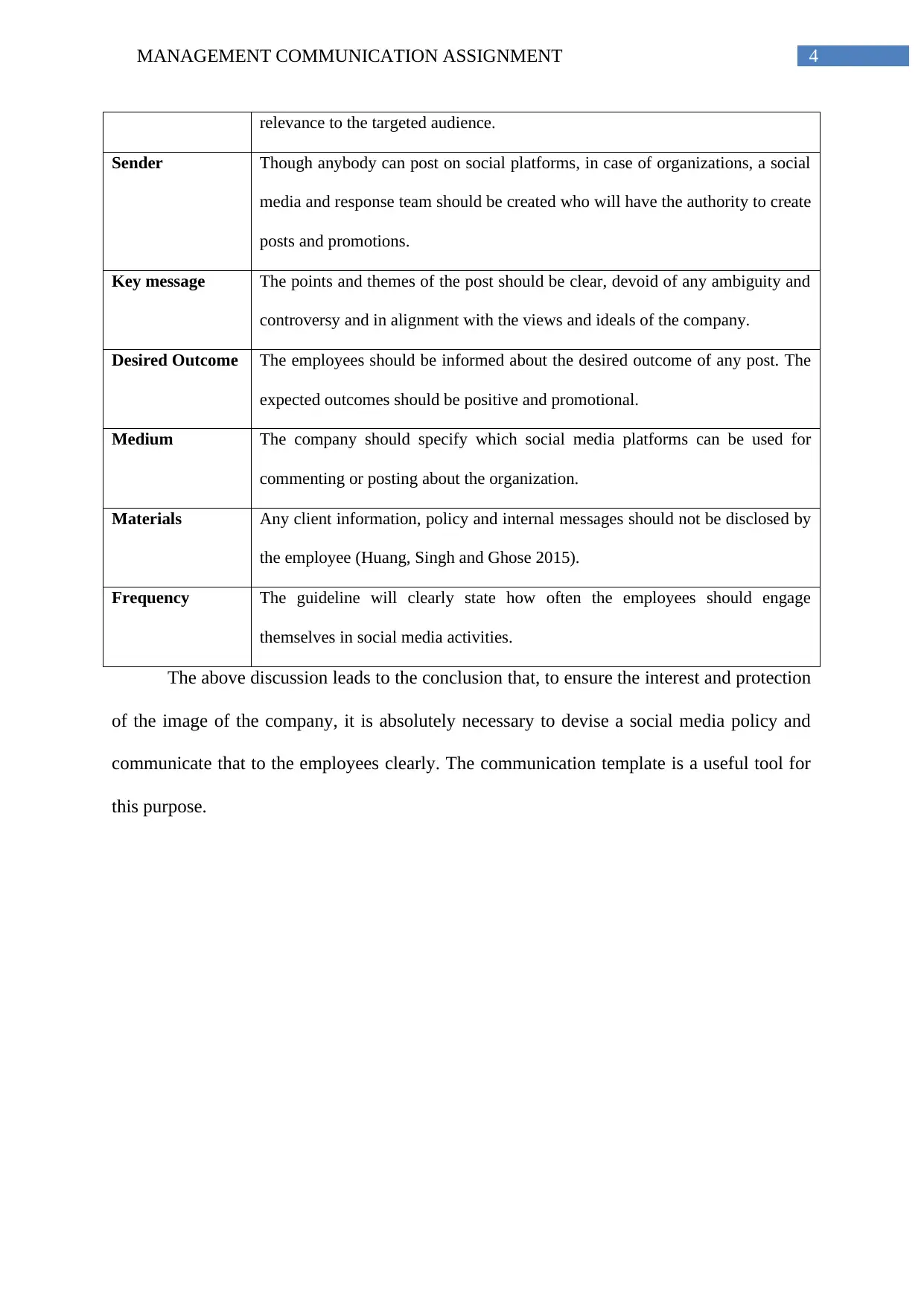
4MANAGEMENT COMMUNICATION ASSIGNMENT
relevance to the targeted audience.
Sender Though anybody can post on social platforms, in case of organizations, a social
media and response team should be created who will have the authority to create
posts and promotions.
Key message The points and themes of the post should be clear, devoid of any ambiguity and
controversy and in alignment with the views and ideals of the company.
Desired Outcome The employees should be informed about the desired outcome of any post. The
expected outcomes should be positive and promotional.
Medium The company should specify which social media platforms can be used for
commenting or posting about the organization.
Materials Any client information, policy and internal messages should not be disclosed by
the employee (Huang, Singh and Ghose 2015).
Frequency The guideline will clearly state how often the employees should engage
themselves in social media activities.
The above discussion leads to the conclusion that, to ensure the interest and protection
of the image of the company, it is absolutely necessary to devise a social media policy and
communicate that to the employees clearly. The communication template is a useful tool for
this purpose.
relevance to the targeted audience.
Sender Though anybody can post on social platforms, in case of organizations, a social
media and response team should be created who will have the authority to create
posts and promotions.
Key message The points and themes of the post should be clear, devoid of any ambiguity and
controversy and in alignment with the views and ideals of the company.
Desired Outcome The employees should be informed about the desired outcome of any post. The
expected outcomes should be positive and promotional.
Medium The company should specify which social media platforms can be used for
commenting or posting about the organization.
Materials Any client information, policy and internal messages should not be disclosed by
the employee (Huang, Singh and Ghose 2015).
Frequency The guideline will clearly state how often the employees should engage
themselves in social media activities.
The above discussion leads to the conclusion that, to ensure the interest and protection
of the image of the company, it is absolutely necessary to devise a social media policy and
communicate that to the employees clearly. The communication template is a useful tool for
this purpose.
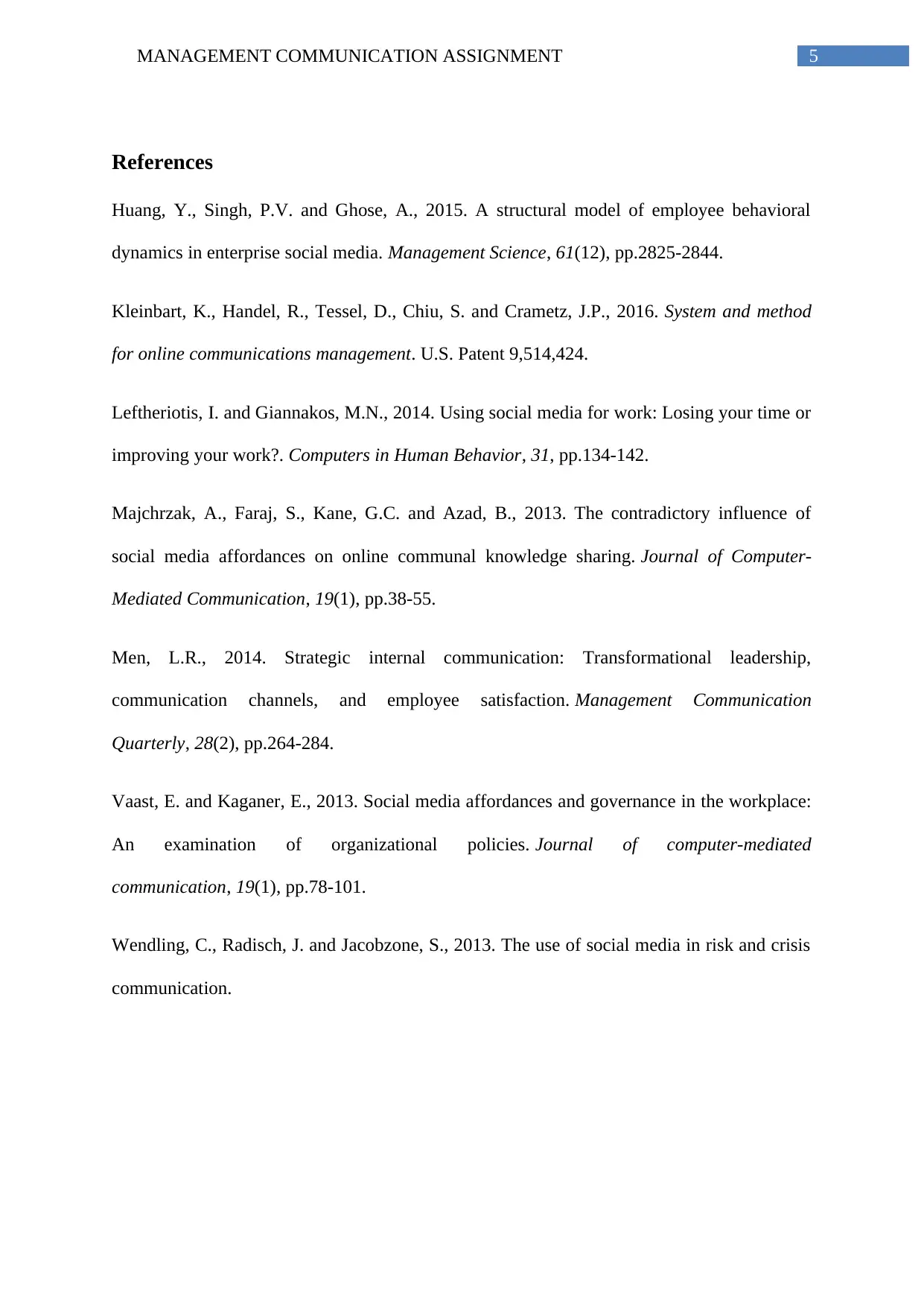
5MANAGEMENT COMMUNICATION ASSIGNMENT
References
Huang, Y., Singh, P.V. and Ghose, A., 2015. A structural model of employee behavioral
dynamics in enterprise social media. Management Science, 61(12), pp.2825-2844.
Kleinbart, K., Handel, R., Tessel, D., Chiu, S. and Crametz, J.P., 2016. System and method
for online communications management. U.S. Patent 9,514,424.
Leftheriotis, I. and Giannakos, M.N., 2014. Using social media for work: Losing your time or
improving your work?. Computers in Human Behavior, 31, pp.134-142.
Majchrzak, A., Faraj, S., Kane, G.C. and Azad, B., 2013. The contradictory influence of
social media affordances on online communal knowledge sharing. Journal of Computer-
Mediated Communication, 19(1), pp.38-55.
Men, L.R., 2014. Strategic internal communication: Transformational leadership,
communication channels, and employee satisfaction. Management Communication
Quarterly, 28(2), pp.264-284.
Vaast, E. and Kaganer, E., 2013. Social media affordances and governance in the workplace:
An examination of organizational policies. Journal of computer-mediated
communication, 19(1), pp.78-101.
Wendling, C., Radisch, J. and Jacobzone, S., 2013. The use of social media in risk and crisis
communication.
References
Huang, Y., Singh, P.V. and Ghose, A., 2015. A structural model of employee behavioral
dynamics in enterprise social media. Management Science, 61(12), pp.2825-2844.
Kleinbart, K., Handel, R., Tessel, D., Chiu, S. and Crametz, J.P., 2016. System and method
for online communications management. U.S. Patent 9,514,424.
Leftheriotis, I. and Giannakos, M.N., 2014. Using social media for work: Losing your time or
improving your work?. Computers in Human Behavior, 31, pp.134-142.
Majchrzak, A., Faraj, S., Kane, G.C. and Azad, B., 2013. The contradictory influence of
social media affordances on online communal knowledge sharing. Journal of Computer-
Mediated Communication, 19(1), pp.38-55.
Men, L.R., 2014. Strategic internal communication: Transformational leadership,
communication channels, and employee satisfaction. Management Communication
Quarterly, 28(2), pp.264-284.
Vaast, E. and Kaganer, E., 2013. Social media affordances and governance in the workplace:
An examination of organizational policies. Journal of computer-mediated
communication, 19(1), pp.78-101.
Wendling, C., Radisch, J. and Jacobzone, S., 2013. The use of social media in risk and crisis
communication.
⊘ This is a preview!⊘
Do you want full access?
Subscribe today to unlock all pages.

Trusted by 1+ million students worldwide
1 out of 6
Related Documents
Your All-in-One AI-Powered Toolkit for Academic Success.
+13062052269
info@desklib.com
Available 24*7 on WhatsApp / Email
![[object Object]](/_next/static/media/star-bottom.7253800d.svg)
Unlock your academic potential
Copyright © 2020–2025 A2Z Services. All Rights Reserved. Developed and managed by ZUCOL.


